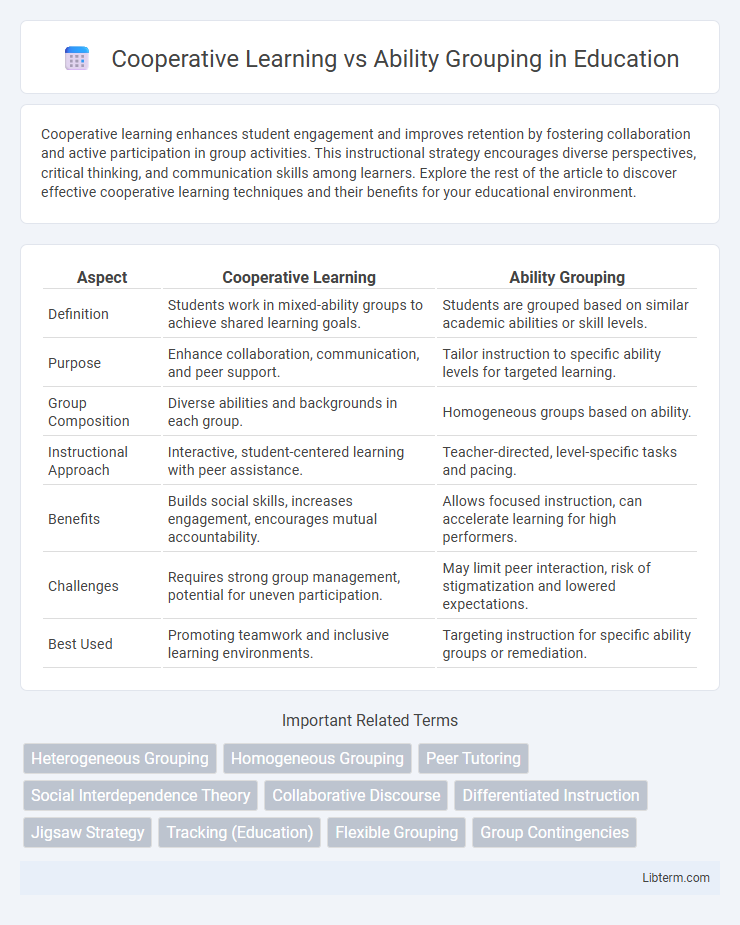Cooperative learning enhances student engagement and improves retention by fostering collaboration and active participation in group activities. This instructional strategy encourages diverse perspectives, critical thinking, and communication skills among learners. Explore the rest of the article to discover effective cooperative learning techniques and their benefits for your educational environment.
Table of Comparison
| Aspect | Cooperative Learning | Ability Grouping |
|---|---|---|
| Definition | Students work in mixed-ability groups to achieve shared learning goals. | Students are grouped based on similar academic abilities or skill levels. |
| Purpose | Enhance collaboration, communication, and peer support. | Tailor instruction to specific ability levels for targeted learning. |
| Group Composition | Diverse abilities and backgrounds in each group. | Homogeneous groups based on ability. |
| Instructional Approach | Interactive, student-centered learning with peer assistance. | Teacher-directed, level-specific tasks and pacing. |
| Benefits | Builds social skills, increases engagement, encourages mutual accountability. | Allows focused instruction, can accelerate learning for high performers. |
| Challenges | Requires strong group management, potential for uneven participation. | May limit peer interaction, risk of stigmatization and lowered expectations. |
| Best Used | Promoting teamwork and inclusive learning environments. | Targeting instruction for specific ability groups or remediation. |
Introduction to Cooperative Learning and Ability Grouping
Cooperative learning involves students working together in small groups to achieve shared academic goals, enhancing social interaction and collective problem-solving skills. Ability grouping organizes students based on their skill levels or achievement, allowing targeted instruction tailored to individual needs. Both approaches aim to improve learning outcomes but differ fundamentally in structure and focus on collaboration versus individual ability.
Defining Cooperative Learning: Key Features
Cooperative learning is defined by structured group activities where students work collaboratively to achieve shared learning goals, promoting interdependence and individual accountability. Key features include positive social interaction, face-to-face promotive interaction, and development of interpersonal skills alongside academic content mastery. This method contrasts with ability grouping, as cooperative learning emphasizes heterogeneous groups to leverage diverse strengths and foster peer support.
Understanding Ability Grouping: Core Concepts
Ability grouping organizes students by similar skill levels to tailor instruction and improve learning efficiency. It allows targeted teaching strategies that address specific strengths and weaknesses within each group. This approach contrasts with cooperative learning by emphasizing skill homogeneity rather than mixed-ability collaboration.
Historical Context and Educational Theories
Cooperative learning emerged in the 1960s as a response to traditional competitive classroom models, influenced by Vygotsky's social constructivism which emphasizes peer interaction and scaffolding for cognitive development. Ability grouping, with roots in the early 20th century, is grounded in behaviorist theories and the belief that sorting students by skill level improves instructional efficiency and targeted learning outcomes. Historical educational reforms reveal a shift from rigid ability grouping toward cooperative learning to promote equity and social skills alongside academic achievement.
Academic Outcomes: A Comparative Analysis
Cooperative learning promotes higher academic outcomes by encouraging peer collaboration, critical thinking, and active engagement, leading to improved comprehension and retention. Ability grouping often results in mixed academic gains, with high achievers benefiting from tailored instruction while lower groups may experience lower motivation and self-esteem. Research indicates cooperative learning fosters inclusive academic growth, reducing achievement gaps compared to ability grouping.
Social and Emotional Impacts on Students
Cooperative learning fosters social skills and emotional resilience by promoting peer interaction, teamwork, and empathy among diverse student groups. Ability grouping can lead to social stigmatization and decreased self-esteem, especially for lower-achieving students, by reinforcing fixed ability labels. Research highlights that cooperative learning environments enhance student motivation and reduce anxiety, supporting overall emotional well-being.
Teacher Roles and Instructional Strategies
In cooperative learning, teachers act as facilitators, designing collaborative tasks that promote peer interaction and shared responsibility, enabling diverse learners to support each other's understanding. In ability grouping, teachers tailor instruction more directly to homogeneous groups by adjusting content complexity and pacing based on students' proficiency levels, focusing on targeted skill development. Instructional strategies in cooperative learning emphasize communication, positive interdependence, and group accountability, whereas ability grouping relies on differentiated lessons and individualized feedback to maximize each student's potential within their ability cluster.
Inclusivity, Diversity, and Equity Considerations
Cooperative learning fosters inclusivity by encouraging diverse student interactions, promoting equity through shared responsibilities and peer support that accommodate varying abilities. Ability grouping, while aiming to tailor instruction, often reduces diversity within groups and risks reinforcing achievement gaps by segregating students based on perceived skill levels. Equity-focused education benefits from cooperative learning's dynamic environment, which cultivates mutual respect and leverages diverse perspectives for improved academic and social outcomes.
Challenges and Criticisms of Each Approach
Cooperative learning faces challenges such as uneven student participation, difficulty in assessing individual accountability, and potential social conflicts within groups. Ability grouping is criticized for reinforcing achievement gaps, stigmatizing lower-performing students, and limiting instructional flexibility by segregating learners based on perceived skill levels. Both approaches require careful implementation to mitigate these issues and promote equitable learning outcomes.
Best Practices and Recommendations for Educators
Cooperative learning enhances student engagement and critical thinking by promoting collaboration and peer support, making it effective for diverse classrooms. Ability grouping, when implemented with flexibility and regular reassessment, allows tailored instruction that meets specific learning needs without stigmatizing students. Educators should combine these approaches by using cooperative learning within mixed-ability groups while strategically applying ability grouping for targeted skill development.
Cooperative Learning Infographic

 libterm.com
libterm.com